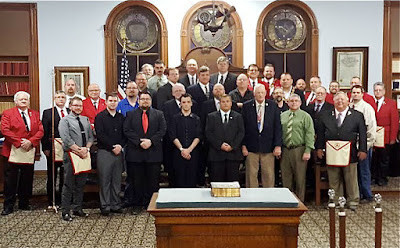They’re back in business! Historic Mariners Lodge 67 will host its legendary Beefsteak Banquet again next month after an interminable absence of, I think, a year. Don’t disappoint yourself by missing out. Tickets are on sale now.
 |
Courtesy Mariners 67
This is not a colorized photo from the 19th century.This is the real deal: the Mariners Beefsteak Banquet. |
(The title of this edition of The Magpie Mason is borrowed from the great Joseph Mitchell’s piece in The New Yorker from 80 years ago in which he traces the history and describes the heavenly joys of the New York beefsteak dinner. Click here, but do as I did decades ago as an optimistic journalism student (ha!) and get a copy of his anthology Up in the Old Hotel, which also includes his “McSorley’s” story. “All You Can Hold for Five Bucks” and others even mention a few Freemasons. Buy yours today!)
From the publicity:
The Festive Board is a feature of the Masonry that extends back to our very beginnings. Operative stonemasons’ lodges would gather upon important occasions around tables laden with food and drink to celebrate in fellowship with the tangible fruits of their labor. Most common were feasts on St. John the Baptist’s Day and St. John the Evangelist’s Day, which were not coincidentally right around the time of the Summer and Winter solstices. These traditions have been part of our Craft ever since. Indeed, one of the reasons given for forming the first Grand Lodge in 1717 was to hold an annual feast.
In the days before Masons had their beautiful purpose-built Masonic temples and lodge rooms, members of the Craft often convened their lodges in taverns and restaurants. The tables were pushed back and Square and Compasses might be scratched out in the sawdust covering the floor while the brethren performed their Masonic work. Before too long the idea arose of taking advantage of what the tavern had to offer, and a practice was born whereby the brethren would take food and drink on a Masonic form and while conducting the work of the lodge.
Over time, various ritual practices of the Festive Board evolved, especially among military officers, who incorporated various elements from their formal dining traditions. These historic rituals and traditions have been resurrected in the modern day, and the Masonic Festive Board with its multiple courses of food, toasts, responses, and giving of “Masonic Fire” has become one of the most popular special events among Masons.
The Mariners Lodge Maritime Festive Board is a unique form of these table ceremonies, which invokes certain early Masonic legends and incorporates elements of historical naval practice and seafaring tradition.
The Mariners Lodge Maritime Festive Board and Beefsteak Banquet incorporates elements from the rich New York tradition of the Beefsteak Banquet – those famous celebrations of gluttony where men gathered to eat massive amounts of aged steak, lamb chops, shrimp cocktail, pork belly and mini-burgers washed down with bottomless schooners of beer. Forks and knives are strictly prohibited, but you will be provided with a butcher’s apron and plenty of napkins!
















































































